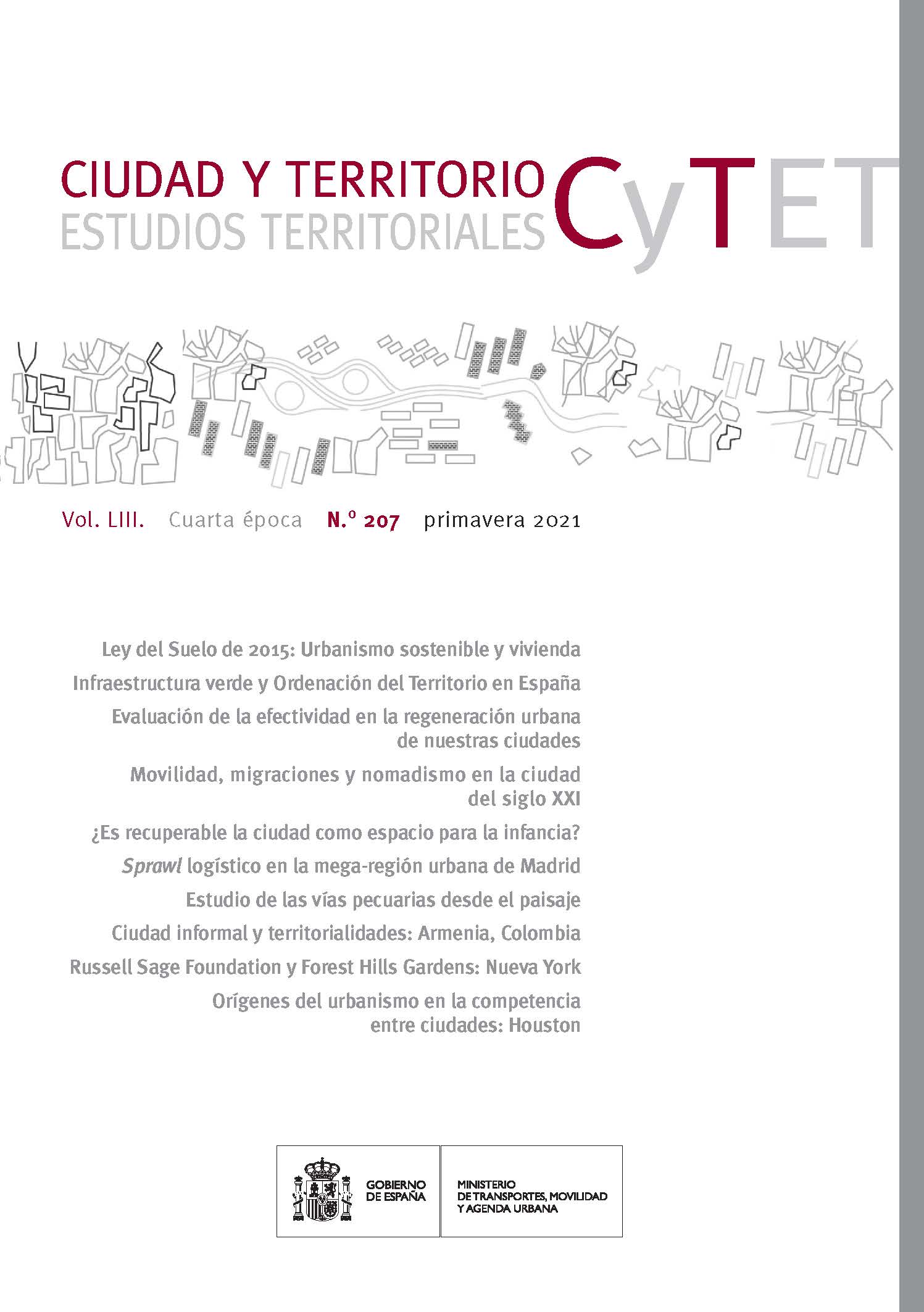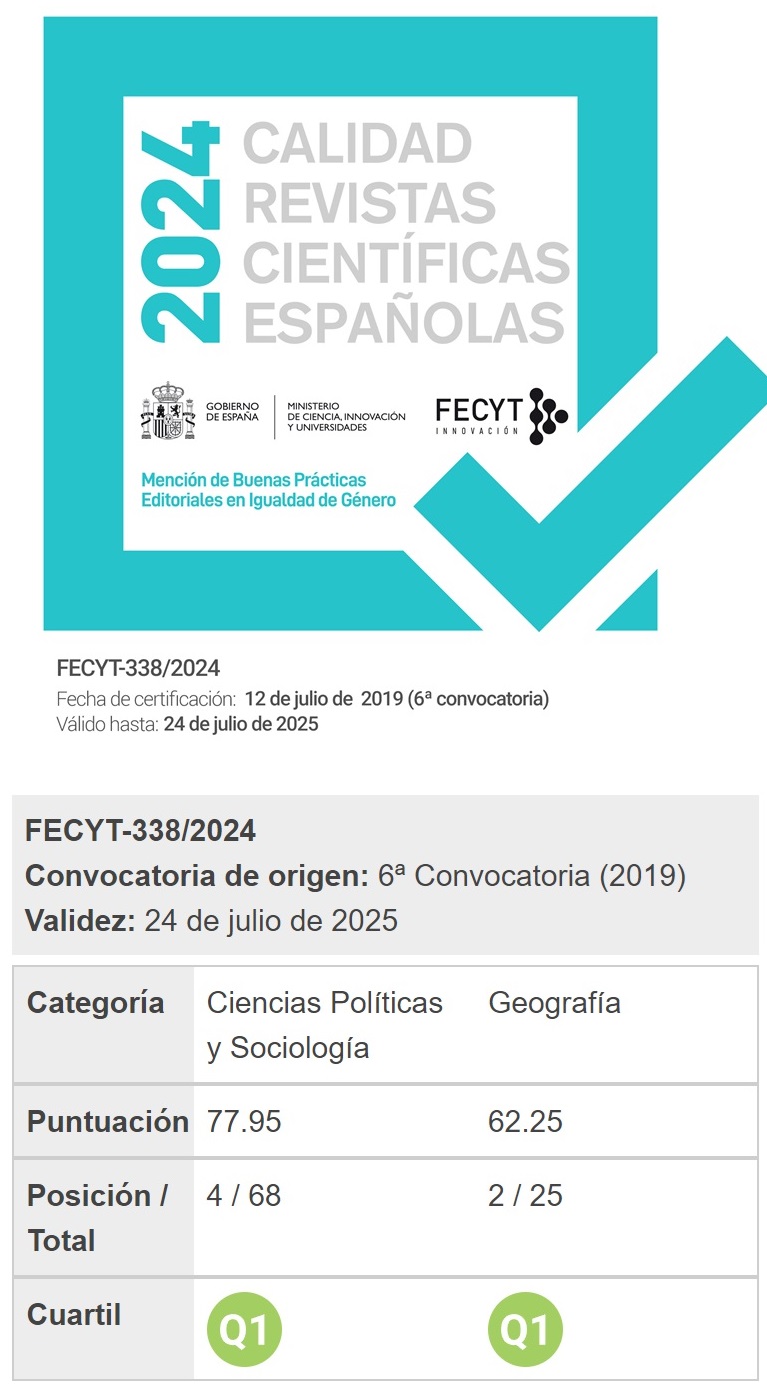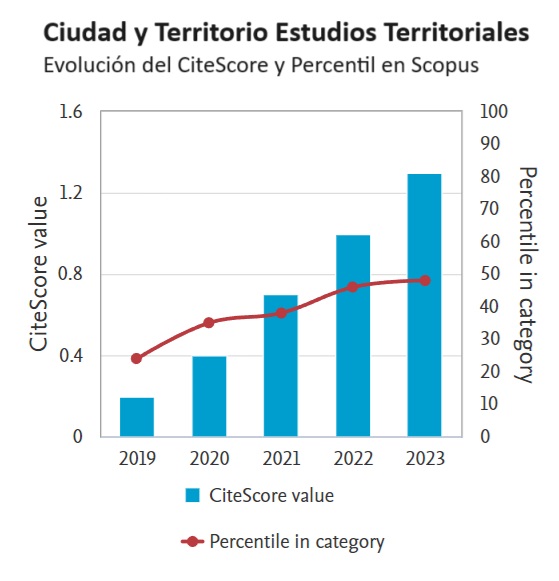La Russell Sage Foundation y Forest Hills Gardens.
Un laboratorio urbanístico en Nueva York entre el determinismo social y la estandarización de la vivienda
DOI:
https://doi.org/10.37230/CyTET.2021.207.09Palabras clave:
Rusell Sage Foundation, Forest Hills Gardens, Nueva York, Unidad vecinal, Determinismo social, ViviendaResumen
En 1909, la Russell Sage Foundation promovió un experimento económico y social consistente en la implantación de una ciudad suburbio modelo en el barrio de Queens (Nueva York): Forest Hills Gardens. La que fuera primera ciudad-jardín americana sintetiza un ejercicio de equilibrio entre la filantropía y la especulación, entre la naturaleza y la ciudad, entre la comunidad y la privacidad, entre la segregación y la inclusión, entre el diseño urbano y el determinismo social, entre la industrialización y el arte, entre la tradición y la modernidad o entre la estandarización y la identidad. En Forest Hills Gardens se evidencian las contradicciones que surgen a menudo entre los resultados de lo que se hace y lo que se quiere hacer, en un momento de enorme trascendencia ante el cambio en la forma de hacer ciudad, alentado por los avances tecnológicos, en Estados Unidos.
Descargas
Citas
AA.VV. (1975): La ciudad americana, Barcelona, España, Gustavo Gili.
Atterbury, G. (1930): The economic production of workingmen’s homes. An outline of a Scientific Solution of the Housing Problem and its relation to the development of the City with Illustrations of actual results obtained from researches and demonstrations 1904-1925, Nueva York, USA, Russell Sage Foundation.
Bauer, C. (1945): Good Neighborhoods. The Annals of the American Academy of Political and Social Science, nº 242, 104-115.
Birch, E. L. (1978): Woman-Made America. The Case of EarlyPublic Housing Policy, Journal of the American Institute of Planners, Volumen 44, nº 2, 130-144. doi:10.1080/01944367808976886.
Cement Age. (1910): Studies in Economic Costruction, Cement Age, diciembre, 314-325.
Ciucci, G. (1977): Qualitá contro disgregazione urbana Forest Hills Gardens. Casabella, nº 41, junio: 57-61.
Crawford, M. (1995): Building the Workingman’s Paradise: The Design of American Company Towns, , Nueva York, USA: Verso.
Duany, A; & Plater-Zyberk, E. & Speck, J. (2000): Suburban Nation, New York, USA, North Point Press.
Forest Hills Gardens. (1915): Why we have chosen Forest Hills Gardens for our home, Nueva York, USA, Forest Hills Gardens.
García-González, M. C. (2018). César Cort (1893-1978) y la cultura urbanística de su tiempo. Madrid, España, Abada Editores.
García-González, M. C. & Guerrero, S. (2017): El urbanismo como acto de comunicación: Theodora Kimball Hubbard y la biblioteca de la Harvard Landscape Architecture School. Scripta Nova: revista electrónica de geografía y ciencias sociales, nº 21, 553-559.
The Survey, Garden City Platted by Russell Sage Foundation (1910): The Survey, Volumen 25, nº 9, 309-310.
Glenn, J. M., Brandt, L., & Andrews, F. E. (1947): Russell Sage Foundation, 1907-1946. Nueva York, USA: Russell Sage Foundation.
Hammack, D. C. (1988): The Russell Sage Foundation. Social Research and Social Action in America, 1907-1947, Mariland, USA, UPA Editions.
Johnson, D. A. (1996): Planning the great metropolis: the 1929 regional plan of New York and its environments, Londres, Gran Bretaña, E & F Spon.
Klaus, S. L. (2002): A modern Arcadia, Frederick Law Olmsted jr. and the plan for Forest Hills. Amherst y Boston, USA: University of Massachussetts Press.
La Correspondencia de España (1913): Lo que él ahorró él lo regala, 15 de septiembre de 1913.
Mann, P. H. (1958): The socially balanced neighborhood unit. The town planning review, Volumen 29, nº 2: 91-98.
Millerson, G. (1964): The Qualifying Association. A Study in Professionalization. Londres, Gran Bretaña, Routledge & Kegan Paul.
Mumford, L. (1925): The Fourth Migration, The Survey, Volumen 54, nº 2, 130-133.
Nolen, J. (1916): City Planning, Nueva York, USA, D. Appleton and Company.
Perry, C. A. (1926): The rehabilitation of the local Community, Social Forces, Volumen 4, nº 3, 558-562.
Perry, C. A. (1929): The Neighbourhood Unit, a Scheme of Arrangement for the Family Life Community, Nueva York, USA, Russell Sage Foundation.
Perry, C. A. (1929): City Planning for Neighborhood Life. Social Forces, Volumen 8, nº1, 98-100. doi:10.2307/2570059
Perry, C. A. (1939): Housing for the machine age. Nueva York, USA: Russell Sage Foundation.
Pennover, P. M. & Walker, A. (2017): The Architecture of Grosvenor Atterbury, Nueva York, USA, The Monacelli Press.
Riis, J. A. (1890): How the other half lives: Studies among the tenements of New York, Nueva York, USA, C. Scribner's sons.
Scott, M. (1969): American City Planning since 1890, Berkeley, USA, University of California Press.
Stern, R. A. M, Gilmartin, G. & Massengale, J. M. (1983): New York 1900: Metropolitan Architecture and Urbanism, 1890-1915, Nueva York, USA, Columbia University.
The Sage Foundation Homes Company (1912): Forest Hills Gardens. The suburban land development of The Russell Sage Foundation, Nueva York, USA, The Sage Foundations Homes Company, panfleto 1.
Veiller, L. (1910): A Model Tenement House Law, Nueva York, USA, Russell Sage Foundation.
Wallace, M. (2018): Greater Gotham: A History of New York City from 1898 to 1919, Nueva York, USA, Oxford University Press.
Wolf, M. A. (1915): Surface treatment of concrete bridges for railway and Highway Traffic. Concrete-Cement Age, Volumen 6, nº 4, 169-175.
Publicado
Cómo citar
Número
Sección
Licencia
Derechos de autor 2021 María Cristina GARCÍA-GONZÁLEZ, Salvador Guerrero

Esta obra está bajo una licencia internacional Creative Commons Atribución-NoComercial-SinDerivadas 4.0.
Sin perjuicio de lo dispuesto en la legislación vigente sobre Propiedad Intelectual, y conforme a la misma, el/la los/las autor/a/es/as que publiquen en CyTET cede/n a título gratuito, de modo no exclusivo y sin límite temporal al Ministerio de Transportes, Movilidad y Agenda Urbana los derechos para difundir, reproducir, comunicar y distribuir en cualquier formato actual o futuro, en papel o electrónico, la versión original o derivada de su obra bajo licencia de Creative Commons Reconocimiento-NoComercial-SinObraDerivada 4.0 Internacional (CC BY-NC-ND 4.0), así como para incluir o ceder a terceros la inclusión de su contenido en índices, repositorios y bases de datos nacionales e internacionales, con referencia y reconocimiento en todo caso de la autoría del mismo.
Además, al realizar el envío, el/la los/las autor/a/es/as declara/n que se trata de un trabajo original en el que se reconocen las fuentes que han sido utilizadas en su estudio, comprometiéndose a respetar la evidencia científica y a no modificar los datos originales para verificar o refutar una hipótesis de partida; que el contenido esencial del mismo no ha sido publicado previamente ni se publicará en ninguna otra obra o revista mientras esté en proceso de evaluación en la revista CyTET; y que no se ha remitido simultáneamente a otra publicación.
Los autores deben firmar un Formulario de Cesión de Derechos, que les será enviado desde la Secretaría de CyTET una vez se acepte su artículo para ser publicado.
Con el objetivo de favorecer la difusión del conocimiento, CyTET se adhiere al movimiento de revistas de Open Access (OA) y entrega la totalidad de sus contenidos a diversos índices, repositorios y bases de datos nacionales e internacionales bajo este protocolo; por tanto, la remisión de un trabajo para ser publicado en la revista presupone la aceptación explícita por parte del autor/a de este método de distribución.
Se anima a las/os autoras/es a reproducir y alojar sus trabajos publicados en CyTET en repositorios institucionales, páginas web, etc. con la intención de contribuir a la mejora de la transferencia del conocimiento y de la citación de dichos trabajos.








 Enlace a CyTET en Linkedin
Enlace a CyTET en Linkedin